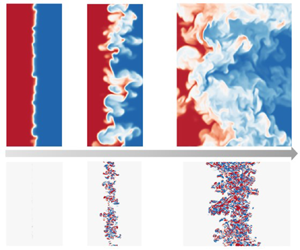Article contents
An intermittency based Reynolds-averaged transition model for mixing flows induced by interfacial instabilities
Published online by Cambridge University Press: 03 January 2025
Abstract

The evolutionary process of mixing induced by Rayleigh–Taylor (RT) and Richtmyer–Meshkov (RM) instabilities typically progresses through three stages: initial instability growth, subsequent mixing transition and ultimate turbulent mixing. Accurate prediction of this entire process is crucial for both scientific research and engineering applications. For engineering applications, Reynolds-averaged Navier–Stokes (RANS) simulation stands as the most viable method currently. However, it is noteworthy that existing RANS mixing models are primarily tailored for the fully developed turbulent mixing stage, rendering them ineffective in predicting the crucial mixing transition. To address that, the present study proposes a RANS mixing transition model. Specifically, we extend the idea of the intermittent factor, which has been widely employed to integrate with turbulence models for predicting boundary layer transition, to mixing problems. Based on a high-fidelity simulation of a RT case, the intermittent factor defined based on enstrophy is extracted and then applied to RANS calculations, showing that it is possible to accurately predict mixing transition by introducing the intermittent factor to the turbulence production from the baseline K-L turbulence mixing model. Furthermore, to facilitate practical predictions, a transport equation has been established to model the spatio-temporal evolution of the intermittent factor. Coupled with the K-L model, the intermittent factor provided by the transport equation is applied to modify the Reynolds stress in RANS calculations. Thereafter, the present transition model has been validated in a series of tests, demonstrating its accuracy and robustness in the capturing mixing process in different types and stages of interfacial mixing flows.
Information
- Type
- JFM Papers
- Information
- Copyright
- © The Author(s), 2025. Published by Cambridge University Press
References
- 8
- Cited by


